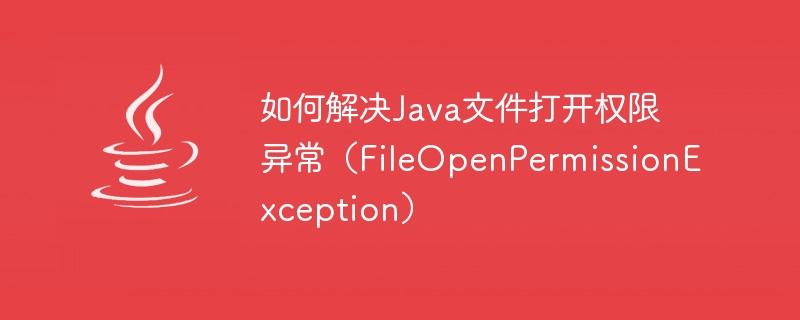 Java
Java
 javaTutorial
javaTutorial
 How to solve Java file opening permission exception (FileOpenPermissionException)
How to solve Java file opening permission exception (FileOpenPermissionException)
How to solve Java file opening permission exception (FileOpenPermissionException)

How to solve Java file opening permission exception (FileOpenPermissionException)
Introduction:
In the process of Java programming, we often encounter file operation problems need. But sometimes, we may encounter Java file open permission exception (FileOpenPermissionException) error. This article will introduce the reasons for this exception and provide several methods to solve it.
- Exception reason:
The java.io.File class is one of the classes used to operate files and directories in Java. When using the File class for file operations, a Java file open permission exception (FileOpenPermissionException) is likely to occur. This exception usually occurs in the following situations:
- does not have the correct file permissions;
- the file is being occupied by other programs;
- the file does not exist.
- Solution:
(Method 1) Check file permissions:
First, we need to check whether we have the correct file permissions. You can use the canRead() and canWrite() methods of Java's File class to check whether the file has read and write permissions. If the file does not have open permission, we can use the setReadable() and setWritable() methods of Java's File class to set the read and write permissions of the file.
The following is a sample code:
import java.io.File;
public class FilePermissionExample {
public static void main(String[] args) {
File file = new File("test.txt");
// 检查文件是否具有读写权限
if (!file.canRead()) {
// 如果没有读权限,设置文件的读权限
file.setReadable(true);
}
if (!file.canWrite()) {
// 如果没有写权限,设置文件的写权限
file.setWritable(true);
}
// 其他文件操作...
}
}(Method 2) Check whether the file is occupied:
If the file is being occupied by other programs, the Java file opening permission is abnormal ( FileOpenPermissionException) will also occur. We can use the isFileLocked() method of Java's File class to check whether the file is locked by other programs.
The following is a sample code:
import java.io.File;
import java.nio.channels.FileChannel;
import java.nio.channels.FileLock;
import java.io.RandomAccessFile;
import java.io.IOException;
public class FileLockExample {
public static void main(String[] args) {
File file = new File("test.txt");
// 检查文件是否被其他程序占用
try (RandomAccessFile randomAccessFile = new RandomAccessFile(file, "rw");
FileChannel fileChannel = randomAccessFile.getChannel();
FileLock fileLock = fileChannel.tryLock()) {
if (fileLock != null) {
// 文件没有被其他程序占用
// 其他文件操作...
} else {
// 文件被其他程序占用
System.out.println("文件被其他程序占用");
}
} catch(IOException e) {
e.printStackTrace();
}
}
}(Method 3) Check whether the file exists:
If the file does not exist, Java file open permission exception (FileOpenPermissionException) will also occur . We can use the exists() method of Java's File class to check whether the file exists. If the file does not exist, we can use the createNewFile() method of Java's File class to create the file.
The following is a sample code:
import java.io.File;
import java.io.IOException;
public class FileExistExample {
public static void main(String[] args) {
File file = new File("test.txt");
// 检查文件是否存在
if (!file.exists()) {
// 如果文件不存在,创建文件
try {
file.createNewFile();
} catch (IOException e) {
e.printStackTrace();
}
}
// 其他文件操作...
}
}Conclusion:
Java file open permission exception (FileOpenPermissionException) usually occurs during file operations, possibly because the file does not have the correct Permissions, being occupied by other programs or the file does not exist. We can resolve this exception by checking file permissions, checking if the file is occupied, and checking if the file exists. In actual development, we should choose appropriate solutions according to specific situations, and perform relevant exception handling and error prompts to ensure the robustness and stability of the program.
The above is the detailed content of How to solve Java file opening permission exception (FileOpenPermissionException). For more information, please follow other related articles on the PHP Chinese website!

Hot AI Tools

Undresser.AI Undress
AI-powered app for creating realistic nude photos

AI Clothes Remover
Online AI tool for removing clothes from photos.

Undress AI Tool
Undress images for free

Clothoff.io
AI clothes remover

AI Hentai Generator
Generate AI Hentai for free.

Hot Article

Hot Tools

Notepad++7.3.1
Easy-to-use and free code editor

SublimeText3 Chinese version
Chinese version, very easy to use

Zend Studio 13.0.1
Powerful PHP integrated development environment

Dreamweaver CS6
Visual web development tools

SublimeText3 Mac version
God-level code editing software (SublimeText3)

Hot Topics
 1382
1382
 52
52

